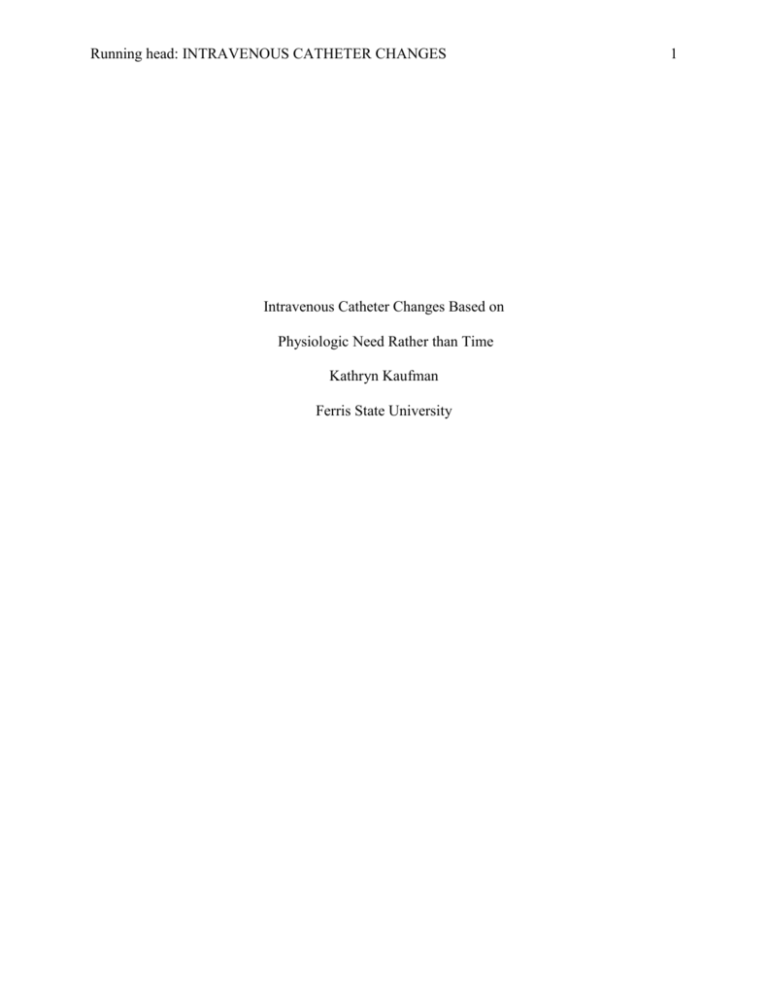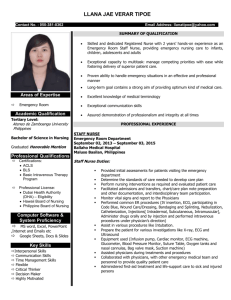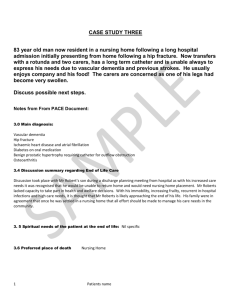PICO Clinical Question Paper: Intravenous Catheter Changes
advertisement

Running head: INTRAVENOUS CATHETER CHANGES Intravenous Catheter Changes Based on Physiologic Need Rather than Time Kathryn Kaufman Ferris State University 1 INTRAVENOUS CATHETER CHANGES 2 Abstract The purpose of this paper is to address a clinical PICOT question: would it be better to change IV (intravenous) catheters only as clinically needed rather than per an arbitrary timeframe? The PICOT acronym will be explained using the question that has been formulated here. If this question were to be proven best practice, some of the reasons why will be addressed as far as how it would be best for quality and safety in patient care. The methods of how the following research has been obtained will be addressed, as well as techniques that were used to find current nursing research on this topic. There will be brief analysis of three different articles found to address this topic, which will include whether or not they are nursing research, and how to distinguish whether they are good, reliable sources. The discussion that follows includes why this information is significant to the nursing profession, and how it would change things for nurses, patients, policies, and professional values that are currently in place. Finally, the American Nurses Association (ANA) standards (on evidence-based practice, communication, and collaboration) will be addressed in connection with the PICOT question, and how this would/will affect nurses’ care for patients. INTRAVENOUS CATHETER CHANGES 3 Intravenous Catheter Changes Based on Physiologic Need Rather than Time This paper will address the clinical significance of this PICOT question in practice: Would it be more beneficial to the patient to wait to replace IV catheters until they are clinically needed, rather than following the guideline of changing it every 96 hours? The purpose of it is to “reflect how nursing knowledge is disseminated for use in personal and professional practice” (Singleterry, 2014, p. 11). It will examine the current medical practice in place and distinguish from it which methods of care are the best, and address some topics which may produce the best outcomes for the patient. Clinical Question The question that will be addressed within this research has some significance to the overall health and well-being of patients. It is regarding the question of whether or not it would be best for the patient’s sake to leave in intravenous (IV) catheters for a period longer than the standard 96 hours, for the purpose of reducing new bacteria to the patient via a different IV site. This information will be presented along the PICO guideline, set forth as a pattern for research, to question the practices already in place within the health care system today. This PICO guideline addresses a specific issue regarding a certain population, intervention, comparison of a new or proposed guideline with the one already in place, desired outcome, and a timeframe to work within (Evidence-Based Medicine Resource Guide, 2014). The population in focus for this study is admitted patients who have been hospitalized for longer than 96 hours, and will need continued IV therapy. An intervention would be to keep from changing the IV catheter every 3-4 days (per hospital policy), but to change them when there was a clinical need to do so (ie. patient discomfort, pain at IV site, patient preference, etc.). Comparison between the two methods is required for this – looking at both the patients’ preference and what is best for their INTRAVENOUS CATHETER CHANGES 4 health overall. Observation would hopefully be that changing IV catheters less frequently would prove to be more beneficial than the standard 96 hour stretch that is policy within many hospitals. The timeframe dealt with would simply be the length of stay within the hospital that the patient required an IV catheter in place. Results observed from this PICO question will change patient quality and safety of care in a few different respects, namely effectiveness. For these results to conclude that it is better for the patient to have fewer IV changes would pave the way for policy changes in many hospitals. Patient comfort is important here, but protection of their health is the biggest concern. Fewer IV changes would hopefully be much more beneficial in both patient comfort and in their best interest for health. However, for this to become a policy within the scope of nursing, much communication and collaboration would be needed to decipher the standards for when an IV actually needs changing. Methodology The search was completed through CINAHL, using keywords like intravenous catheter(s), time/timing, and nursing practice. Filters were used to narrow the search more, such as date of publication (within the last five years), whether or not it was from nursing journals, etc. The results yielded roughly 10 articles of current research regarding time recommended between changing IV catheters. For the purposes of this assignment, three of these articles were chosen for review relating to the PICO question (Singleterry, 2014). The importance of utilizing nursing research among other types of research is for the purpose that it is unique to the profession. Nursing research, above other research, is usually written by nurses, published through nursing journals (which means that they will be tested/reviewed by nursing experts or nurses), and typically has to do with common practices of INTRAVENOUS CATHETER CHANGES 5 nurses. Nursing research also speaks to the profession in its own “language,” approaching topics with a nursing mind *(thinks like a nurse) and using descriptions that are commonly known to the nurse. For PICO questions, use of nursing research is vital since the practices are concerning things that nurses specifically will do. In researching information and data that is nursing research, the ideal sort of data comes from a systematic review (which is the highest sort of research study) and according to the American Association of Critical Care Nurses (AACN) is a Level A type of evidence. This type of evidence is the most desirable for research because in order for a systematic review to be done, much research and testing would have already been done. Changes to policies are more likely to occur based on research from systematic reviews and meta-analyses for these reasons. The most common types of research that were found through these searches were Levels B or C according to the AACN, which are also acceptable for PICO questions. Discussion of Literature Indwell times, complications, and costs of open vs. closed safety peripheral intravenous catheters: A randomized study This article focused very much on dwell times for peripherally inserted intravenous (IV) catheters, an issue that is within the nurse’s scope of practice. The article itself was written by several people who engage in the medical field in Spain, two thirds of whom work in the nursing field (Lopez et al., 2014). This article was published by the Journal of Hospital Infection, and deals with issues that would arise in the healthcare field. Because of several of the authors having a nursing background, and the topic in question being a matter concerning nurses, this article is nursing research. Lopez makes the purpose of the article clear: “to compare closed system PIVCs (peripheral intravenous catheters) with open system (MOS) PIVCs” (Lopez et al., INTRAVENOUS CATHETER CHANGES 6 2014). For the purposes of this paper, the focus will more be on the closed system PIVCs and their standard dwell times. The study itself is a randomized control study, a study in which the participants are assigned randomly to one of two (or several) groups, with at least one receiving an intervention (Dahlgren Memorial Library, 2014). This means that according to the AACN levels of evidence, it would be a Level B, because it is a well-designed control study with results that support a specific intervention (Armola et al., 2009). No internal review boards were mentioned to have approved the study, although “to the authors’ knowledge, this is the first study to compare open and closed safety PIVCs” (Lopez et al., 2014, p. 2). The number of participants in this study equaled 1,199; however the number of participants using the closed system IVs was 584. The results from this study concluded that closed systems are superior to open systems, and can last for longer than 96 hours (though no specific number of hours was listed), and patients using it are less likely to develop phlebitis (Lopez et al., 2014). As to the article’s credibility, out of the 38 sources used, only 8 of them were from the last 5 years, a factor which should prompt more studies to be done on this issue. Factors Influencing Nurses’ Decision-Making Process on Leaving in the Peripheral Intravenous Catheter After 96 Hours The purpose of this article was to discuss the factors behind why nurses decide whether or not to leave in a peripheral IV for more than the standard 96 hour period (Palese et al., 2011). All the authors are nurses, writing about a nursing intervention (leaving in or taking out IV catheters). The article was also published by a medical journal (Lancet). It is a longitudinal study, meaning that it takes a look at qualitative information that has been gathered over a longer INTRAVENOUS CATHETER CHANGES 7 period of time (Nieswiadomy, 2008). It is a Level C according to AACN, which includes qualitative studies that are correlational or descriptive (Armola et. al., 2009). The study itself was performed with a total of 166 participants at several different hospitals, each of which had an internal review board (IRB) who approved the study being done. “To avoid personal bias, this process was first conducted by researchers, who worked independently…” (Palese et al., 2011, p. 3-4). The results of the study concluded that there are many factors that influence the nurses’ decision of whether or not to leave in a peripheral IV catheter for longer than the standard 96 hours, if it is clinically unnecessary. Mostly though, it varies from case to case of whether or not changing of PIVCs is needed sooner or later (Palese et al., 2011). However, the decision to change IV catheters was done or not done due to clinical need (Palese et al., 2011). Of the article’s sources, almost half of them were written within the last 5 years, supporting the findings of this study. Routine Versus Clinically Indicated Replacement of Peripheral Intravenous Catheters The final article comes from research done in Australia in several hospitals. None of the authors were nurses, although the article addresses certain issues that are nursing interventions. Ethics committees gave their approval of the studies being done, the purpose being “to understand the effect of extension of intravenous catheter dwell-time beyond 3 days with replacement of catheters only for clinical reasons” (Rickard et. al., 2012, p.2). The study was organized as a randomized control trial, and rated as a level B according to the AACN levels of evidence (Armola et. al., 2009). A total of 3,283 people were a part of this study, and were randomly assessed once they had met the criteria for the study. Twelve out of the 35 total sources were articles or studies done from the last 5 years, and from these data that were presented, it is concluded by Rickard that, “Our data strongly suggests that routine INTRAVENOUS CATHETER CHANGES 8 replacement does not [reduce complications], but rather causes many unnecessary invasive procedures” (Rickard et. al., 2013, p. 7). Basically, it was found that it does not help the patient (as much as was previously thought) to change IV catheters as often as is currently being done. Significance to Nursing Through some of the research mentioned, as well as information taken from hospitals and patients’ preference, this issue may be on its way to change. More research would be needed for all hospitals to change their standards. However, the Centers for Disease Control (CDC) states that, “More recent studies suggest that administration sets may be used safely for up to 7 days if used in conjunction with antiseptic catheters, or if fluids that enhance microbial growth have not been used” (Centers for Disease Control, 2011). The highest level of research would be either a meta-analysis or systematic review, a Level A according to the AACN (Armola et. al., 2009). Although neither of these studies have been done for this topic, one might be needed in support of this specific nursing intervention before changing any policies. The articles reviewed above are either Level B (either randomized or non-randomized control studies that support specific interventions) or Level C (studies done on different levels that have inconsistent results) (Armola et. al., 2009). Were this to become a change in the common practice in all hospitals for inpatients requiring IV catheters for greater than 96 hours, there would be several advantages, both to the patients’ comfort and cost to the patient and facilities. It would also require that nurses have the appropriate knowledge (provided through research and their own education) and experience to identify when it is appropriate to change the IV, making their practice “evidence-based” (ANA, 2014). This would lead to the increasing need for good communication within the profession, which is one of the American Nurses’ Association (ANA) standards of practice (ANA, 2014). INTRAVENOUS CATHETER CHANGES 9 Interdisciplinary collaboration, as well as patient-provider collaboration, would be needed to help make any changes to current methods “stick.” This can be achieved by engaging the patient and family members of the patient in care (ANA, 2014). Conclusion Intravenous catheter changes happen every day in hospitals around the world. Often, frequent changes are normal for some patients due to their physical state. However, many of the IV changes occur in patients who do not need them (clinically speaking), yet receive them in spite of this. Nurses are the first medical professionals who will have direct contact with their patient. They are educated in classes and taught through experience about what their patients might need. Leaving the choice of when to change the IV catheter up to the nurse (rather than following an arbitrary timeframe) may be the more reasonable way to go, and may even decrease the risk of introducing bacteria into their patients’ bodies. INTRAVENOUS CATHETER CHANGES 10 References American Nurses Association. (2014). Nursing research. Retrieved from http://www.nursingworld.org . Armola, R. R., Bourgault, A. M., Halm, M. A., Board, R. M., Bucher, L., Harrington, L., Heafey, C. A., Lee, R., Shellner, P.K., & Medina, J. (2009). AACN levels of evidence: What’s new?. Critical Care Nurse, 29(4), 70-73. Centers for Disease Control. (2011). 2011 Guidelines for the prevention of intravascular catheter-related infections. Centers for Disease Control and Prevention. Retrieved from http://www.cdc.gov/hicpac . Dahlgren Memorial Library. (2014). Evidence-based medicine resource guide. Health Sciences Library at Georgetown University. Retrieved from http://researchguides.dml.georgetown.edu . González López, J., Arribi Vilela, A., Fernández Del Palacio, E., Olivares Corral, J., Benedicto Martí, C., & Herrera Portal, P. (2014). Indwell times, complications and costs of open vs closed safety peripheral intravenous catheters: A randomized study. Journal Of Hospital Infection, 86(2), 117-126. doi:10.1016/j.jhin.2013.10.008 Nieswiadomy, R. M. (2008). Foundations of nursing research (5th ed.). Upper Saddle River, NJ: Pearson. Palese, A., Cassone, A., Kulla, A., Dorigo, S., Magee, J., Artico, M., ... Sclauzero, P. (2011). Factors influencing nurses' decision-making process on leaving in the peripheral intravascular catheter after 96 hours: A longitudinal study. Journal Of Infusion Nursing, 34(5), 319-326. doi:10.1097/NAN.0b013e3182290a20 INTRAVENOUS CATHETER CHANGES 11 Rickard, C., Webster, J., Wallis, M., Marsh, N., McGrail, M., French, V., ... Whitby, M. (2012). Routine versus clinically indicated replacement of peripheral intravenous catheters: A randomised controlled equivalence trial. Lancet, 380(9847), 1066-1074. doi:10.1016/S0140-6736(12)61082-4 Singleterry, L. (2014). NURS 350 Research in Nursing [Syllabus]. p. 11.







